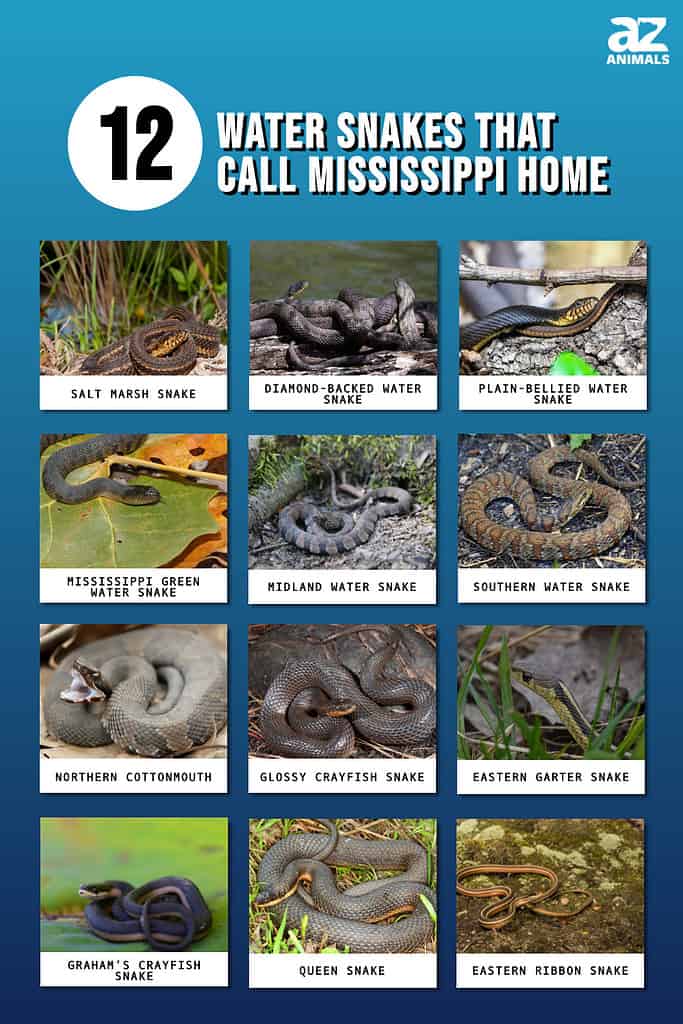
Mississippi is a stunning state in the southeastern region of the US and is home to 55 different species of snakes. It has a vast number of aquatic habitats, including the famous Mississippi River. Although only snakes in the Nerodia genus are true water snakes, there are also several semi-aquatic snakes which also inhabit the state. So, let’s take a look at the water snakes in Mississippi and discover if any of them are dangerous!
1. Salt Marsh Snake (Nerodia clarkii)

Salt marsh snakes typically inhabit salt marshes along the coast of Mississippi.
©Jay Ondreicka/Shutterstock.com
The first snake on our list is the salt marsh snake which is only found in the southern region of the state. As their name suggests, they typically inhabit salt marshes and other brackish areas along the coast. They are not venomous and prey on fish, shrimp, and crabs. They are primarily nocturnal and often search for prey that have become trapped in small pools by the receding tide. There are three subspecies of these snakes, and the Gulf salt marsh snake is the subspecies that is typically found in Mississippi. They are 15 to 30 inches long and have two yellow to tan dorsal stripes over a grey to brown ground color. They also have a row of white spots on their belly.
2. Diamond-Backed Water Snake (Nerodia rhombifer)

Diamond-backed water snakes rarely stray far from water and often hang from branches near the shore.
©Laurie L. Snidow/Shutterstock.com
Next, we have the diamond-backed water snake which is a large snake that reaches 30 to 48 inches long. Diamond-backed water snakes are dark brown with black blotches on their sides which are connected by diagonal black lines, creating a net-like pattern. Diamond-backed water snakes are highly aquatic and live in swamps, lakes, rivers, and ditches all over Mississippi. They rarely stray far from water and can often be observed basking in the sun on the shore, or hanging from overhanging branches. They predominantly eat fish and have very sharp teeth to help them grab and hold onto their prey. Diamond-backed water snakes can be aggressive if threatened and will hiss and bite. They are not venomous but their bites can still be painful.
3. Plain-Bellied Water Snake (Nerodia erythrogaster)
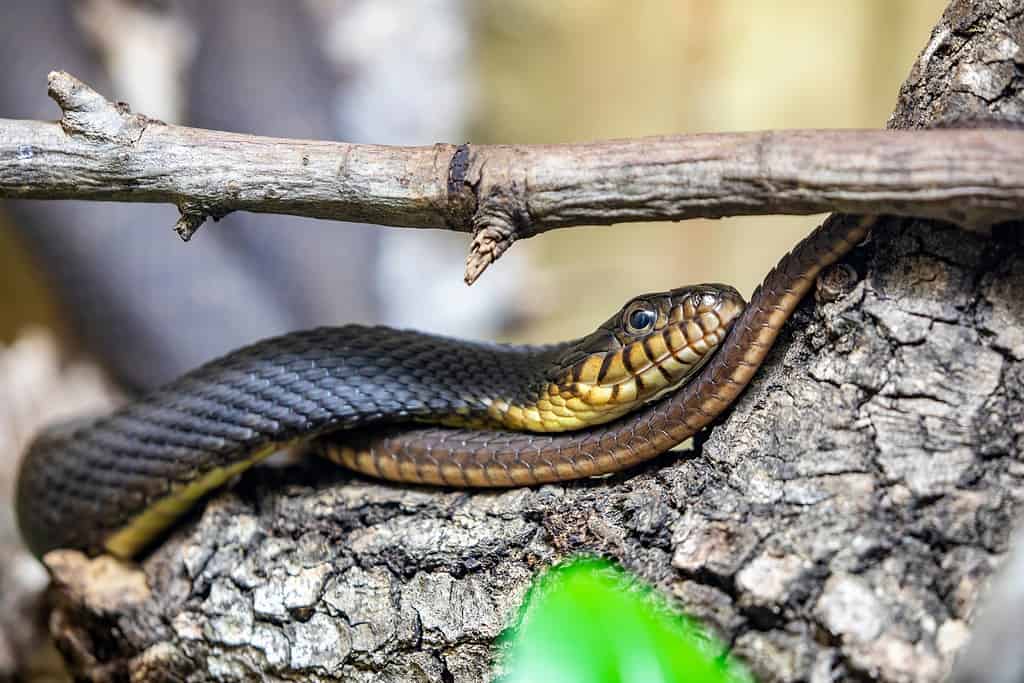
Plain-bellied water snakes have plain-colored, unmarked bellies.
©Danny Ye/Shutterstock.com
Another water snake in Mississippi is the plain-bellied water snake which is so named because of its unmarked red, yellow, or orange belly. They are 30 to 48 inches long and are greenish gray on their dorsal side. Plain-bellied water snakes are widespread across the majority of the state, with the exception of the far north east. They inhabit large bodies of water such as swamps, lakes, and rivers. They mainly eat small fish and amphibians which they grab and swallow alive. Plain-bellied water snakes are quick to flee when they are disturbed and rarely bite unless as a last resort.
4. Mississippi Green Water Snake (Nerodia cyclopion)

Mississippi green water snakes typically inhabit slow-moving bodies of water.
©Rusty Dodson/Shutterstock.com
Another large, harmless snake is the Mississippi green water snake which is 30 to 45 inches long. Mississippi green water snakes are dark green to brown with small, dark markings on their back and sides. However, these markings are most prominent when the snake is young and they gradually fade and then disappear completely as the snake ages. Mississippi green water snakes also have several small but noticeable scales underneath their eyes. They also have a number of light-colored semi-circle markings on their belly. Mississippi green water snakes inhabit slow-moving areas of water, such as swamps and marshes, along the coast and the Mississippi River delta.
5. Midland Water Snake (Nerodia sipedon pleuralis)
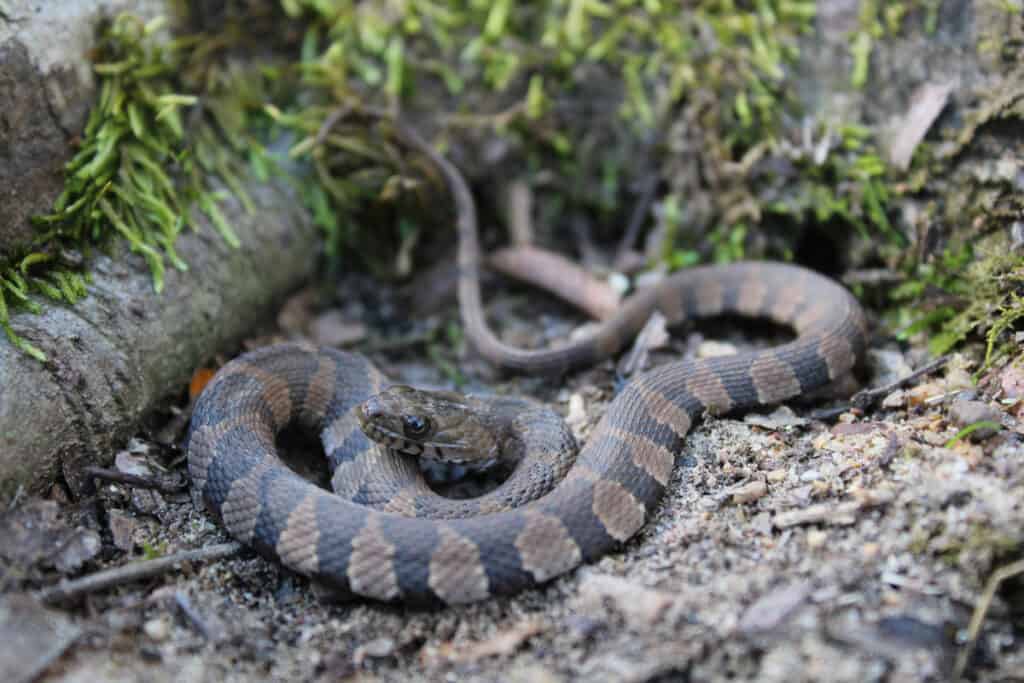
The midland water snake can be found in the central and eastern regions of Mississippi.
©Tucker Heptinstall/Shutterstock.com
The next snake is the Midland water snake which is a subspecies of the northern water snake. Midland water snakes are 24 to 30 inches long and have light brown bodies with approximately 30 dark brown crossband markings. As they get closer to the tail the crossbands turn into blotches. They also have a yellowish-colored belly which has reddish half-moon markings. Midland water snakes are most common in the eastern and central regions of the state where they inhabit lakes, rivers, swamps, and ditches.
6. Southern Water Snake (Nerodia fasciata)
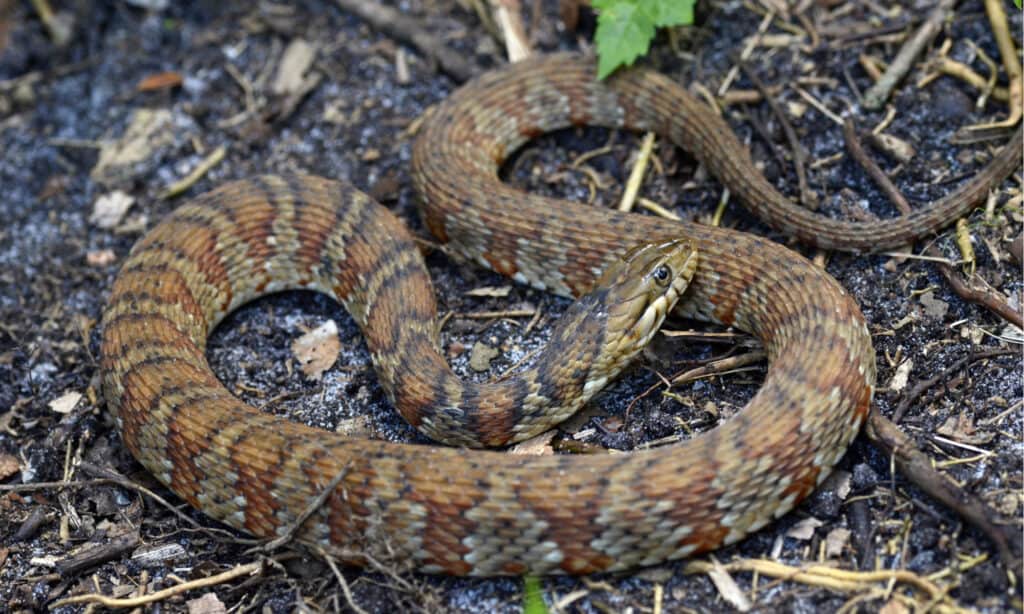
Southern water snakes have large, reddish-colored crossbands.
©Patrick K. Campbell/Shutterstock.com
The final true water snake in Mississippi is the southern water snake, which is also known as the banded water snake. Southern water snakes are 22 to 42 inches long and have gray or tan bodies with large red, black, or brown crossbands. However, these can darken as the snake ages, so eventually it become almost entirely black. They also have a pale white or cream belly with red markings. Southern water snakes are not venomous and primarily eat fish and frogs. They are widespread in the coastal region and in the drainage systems from the Mississippi River.
7. Northern Cottonmouth (Agkistrodon piscivorus)
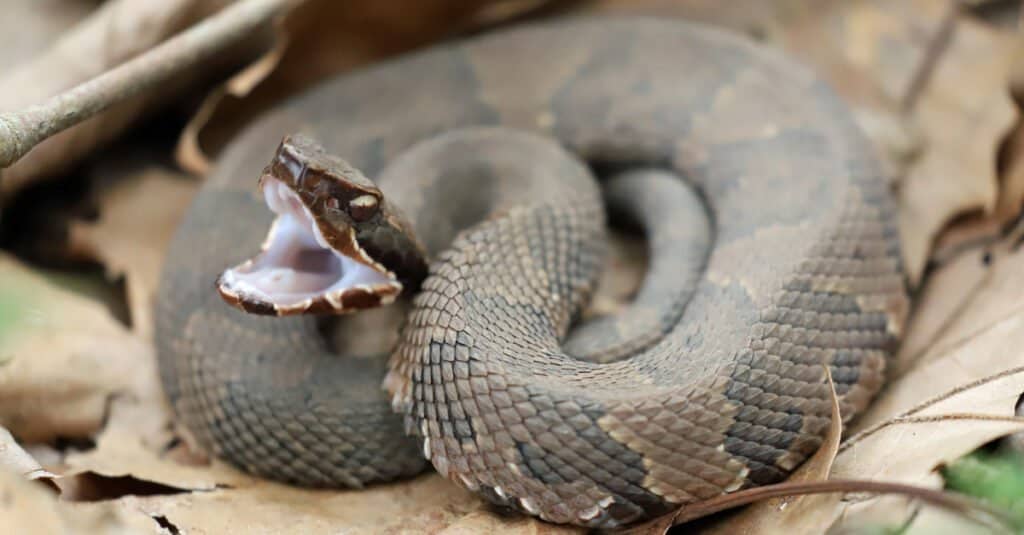
Cottonmouths can be distinguished by the white lining inside their mouth.
©KF2017/Shutterstock.com
The only venomous and truly dangerous snake on the list is the northern cottonmouth. Cottonmouths are 30 to 42 inches long and have dark brown bodies with black crossband markings. However, their most distinctive feature is their mouth which has a bright white lining. Cottonmouths typically open their mouth and expose this when they are coiled in a defensive position. Cottonmouths are widespread across the entire state and live in any freshwater habitat. Although bites from these snakes are rarely fatal, they do possess cytotoxic venom which can cause extensive tissue damage. This can sometimes lead to tissue death and result in amputation of the affected limb.
8. Glossy Crayfish Snake (Liodytes rigida)
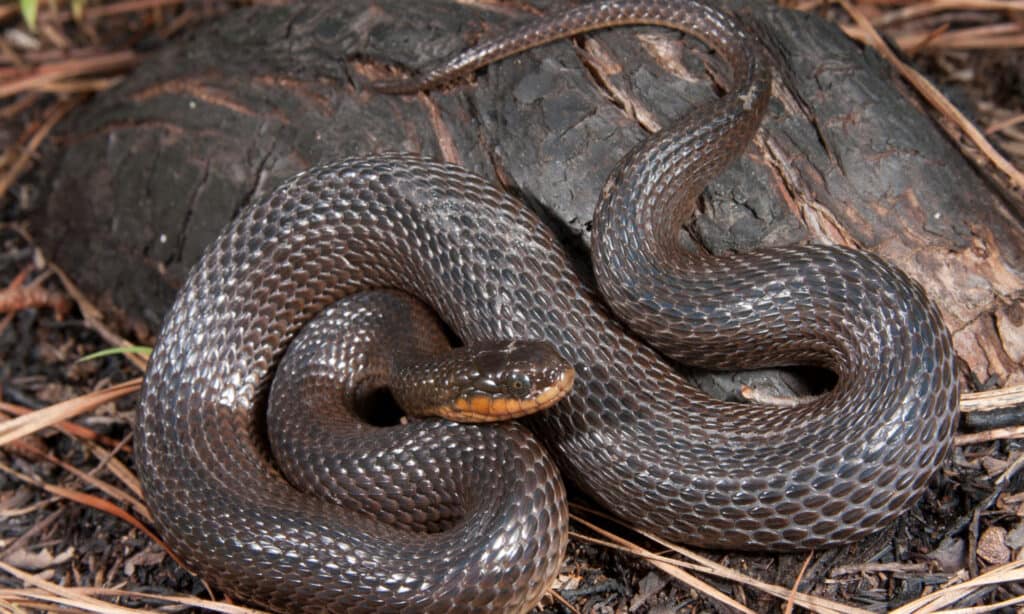
Glossy crayfish snakes mainly live in the southern region of Mississippi.
©Nathan A Shepard/Shutterstock.com
Also known as the glossy swamp snake, the glossy crayfish snake inhabits swamps, ditches, and other slow-moving wetland areas. They mainly live in the southern region of Mississippi as well as parts of the Mississippi delta. Glossy crayfish snakes are fairly small snakes at only 14 to 24 inches long. They have glossy brown bodies with dark stripes down their back and each side. They also have distinctive yellow lips and yellow bellies with black half-moon markings. Glossy crayfish snakes are nocturnal and prey on crayfish, frogs, and fish. They are not venomous and typically flee when disturbed.
9. Eastern Garter Snake (Thamnophis sirtalis sirtalis)
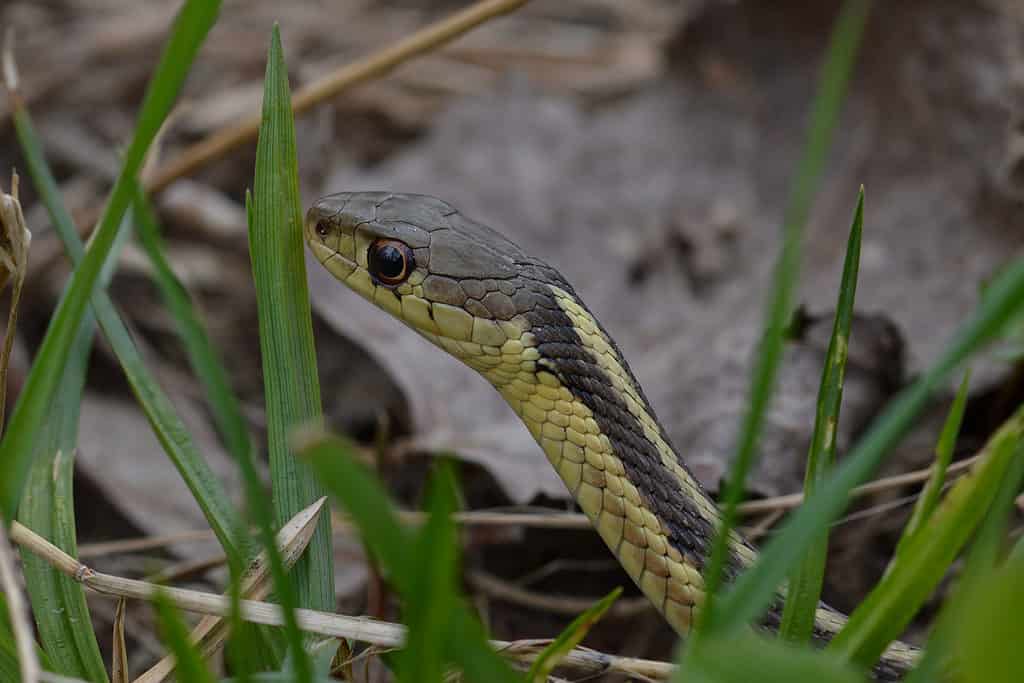
Eastern garter snakes live in and around water where they prey on fish and frogs.
©Ryan Hodnett, CC BY-SA 4.0, via Wikimedia Commons – License
The next water snake in Mississippi is the eastern garter snake which is a subspecies of the common garter snake. Eastern garter snakes are typically 18 to 26 inches long and are brown or black with white or yellow stripes. Although they are not true water snakes, eastern garter snakes commonly live in areas close to a permanent source of water. They are widespread across the state and inhabit areas near lakes, rivers, swamps, and streams. They largely prey on fish and frogs, but they will also eat slugs and worms. Eastern garter snakes are not venomous to humans, but they are mildly venomous to their prey. They produce a venom-like substance in their Durvenoy’s gland which they chew into their prey.
10. Graham’s Crayfish Snake (Regina grahamii)
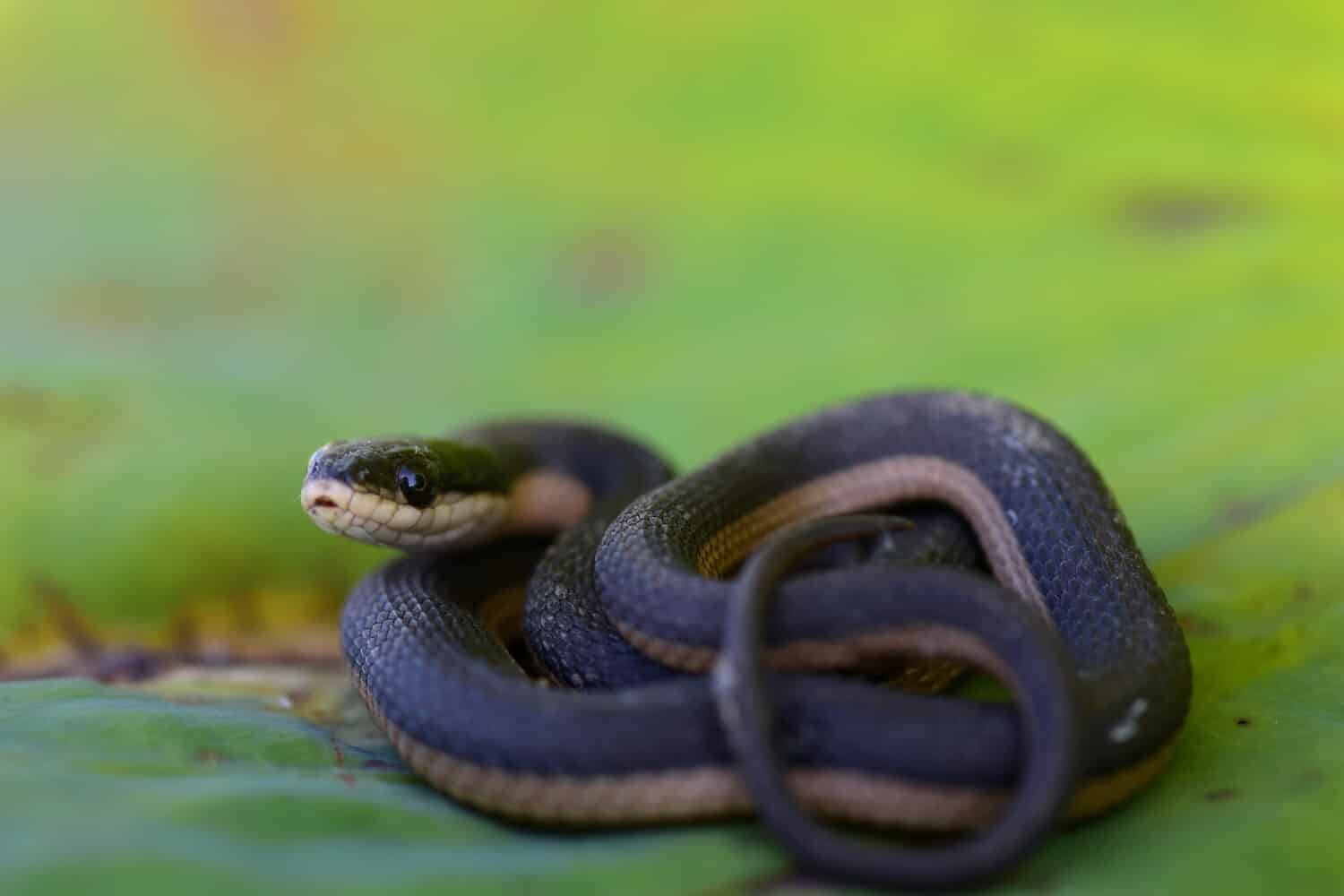
Graham’s crayfish snakes prey predominantly on crayfish.
©Rusty Dodson/Shutterstock.com
Another crayfish snake in Mississippi is Graham’s crayfish snake which inhabits ponds and swamps in the area around the Mississippi River. Graham’s crayfish snakes are 18 to 26 inches long and are brown to gray on their dorsal side. However, they have a cream to yellow belly which is sometimes marked with small, black spots. Graham’s crayfish snakes are not dangerous and prey predominantly on crayfish.
11. Queen Snake (Regina septemvittata)

Queen snakes have thick scales on their heads to protect them when they search underneath rocks for crayfish.
©Jason Patrick Ross/Shutterstock.com
A snake that is particularly well adapted to its aquatic lifestyle is the queen snake. Queen snakes have flattened heads with thickened scales on them. They live in rocky bottomed streams and these scales protect them when they reach underneath and between the rocks in search of crayfish. Queen snakes are 15 to 24 inches long and have brown bodies and yellow bellies. They also have four dark ventral stripes. Queen snakes are state endangered and live in scattered locations in the eastern region.
12. Eastern Ribbon Snake (Thamnophis saurita saurita)

Eastern ribbon snakes are accomplished swimmers and prey on a variety of fish and amphibians.
©Jay Ondreicka/Shutterstock.com
Our final snake is the eastern ribbon snake which is a subspecies of the ribbon snake. They are fairly common through Mississippi and inhabit woodlands and grasslands near to water. They are accomplished swimmers and prey on a variety of fish and amphibians. Eastern ribbon snakes are typically 18 to 33 inches long and have brown bodies with three yellow stripes on their back and sides. They are not venomous and rarely bite. Instead, they release a foul smelling musk if they are handled.
Summary of the 12 Snakes That Call Mississippi Home
Here are the 12 Snakes That Call Mississippi Home:
| Rank | Snakes |
|---|---|
| 1 | Salt Marsh Snake |
| 2 | Diamond-Backed Water Snake |
| 3 | Plain-Bellied Water Snake |
| 4 | Mississippi Green Water Snake |
| 5 | Midland Water Snake |
| 6 | Southern Water Snake |
| 7 | Northern Cottonmouth |
| 8 | Glossy Crayfish Snake |
| 9 | Eastern Garter Snake |
| 10 | Graham’s Crayfish Snake |
| 11 | Queen Snake |
| 12 | Eastern Ribbon Snake |
The photo featured at the top of this post is © Tucker Heptinstall/Shutterstock.com
Discover the "Monster" Snake 5X Bigger than an Anaconda
Every day A-Z Animals sends out some of the most incredible facts in the world from our free newsletter. Want to discover the 10 most beautiful snakes in the world, a "snake island" where you're never more than 3 feet from danger, or a "monster" snake 5X larger than an anaconda? Then sign up right now and you'll start receiving our daily newsletter absolutely free.
Thank you for reading! Have some feedback for us? Contact the AZ Animals editorial team.






